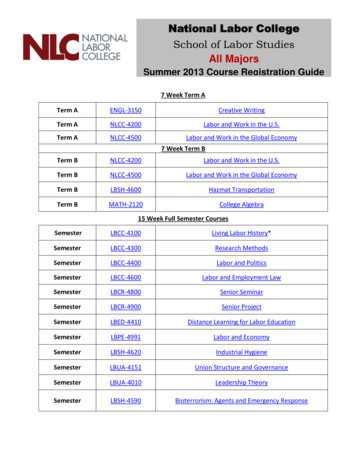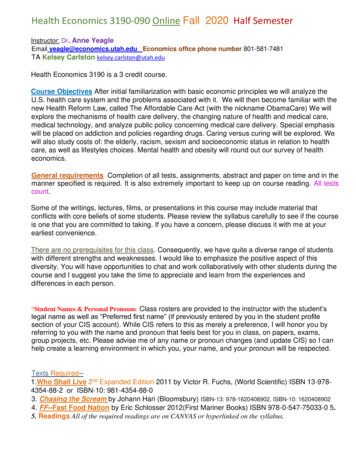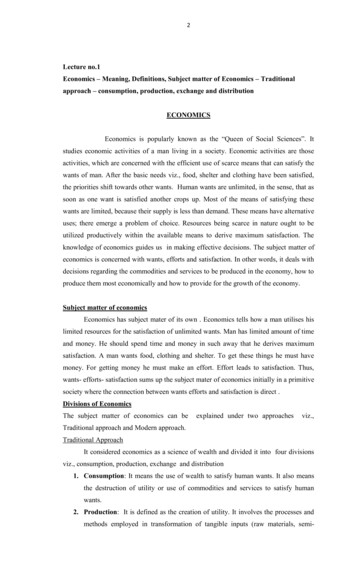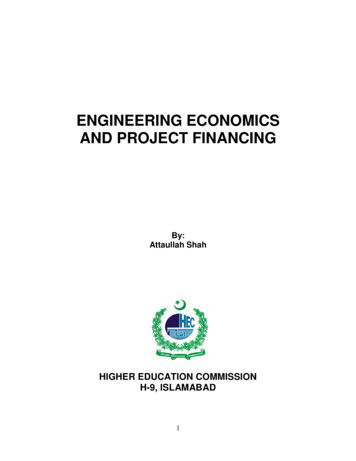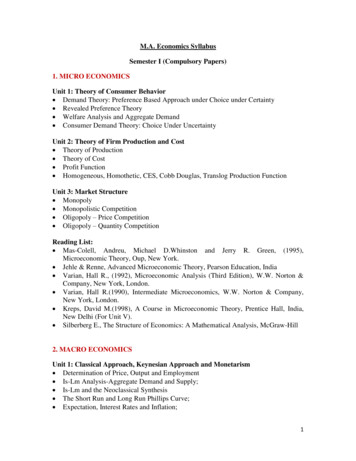
Transcription
M.A. Economics SyllabusSemester I (Compulsory Papers)1. MICRO ECONOMICSUnit 1: Theory of Consumer Behavior Demand Theory: Preference Based Approach under Choice under Certainty Revealed Preference Theory Welfare Analysis and Aggregate Demand Consumer Demand Theory: Choice Under UncertaintyUnit 2: Theory of Firm Production and Cost Theory of Production Theory of Cost Profit Function Homogeneous, Homothetic, CES, Cobb Douglas, Translog Production FunctionUnit 3: Market Structure Monopoly Monopolistic Competition Oligopoly – Price Competition Oligopoly – Quantity CompetitionReading List: Mas-Colell, Andreu, Michael D.Whinston and Jerry R. Green, (1995),Microeconomic Theory, Oup, New York. Jehle & Renne, Advanced Microeconomic Theory, Pearson Education, India Varian, Hall R., (1992), Microeconomic Analysis (Third Edition), W.W. Norton &Company, New York, London. Varian, Hall R.(1990), Intermediate Microeconomics, W.W. Norton & Company,New York, London. Kreps, David M.(1998), A Course in Microeconomic Theory, Prentice Hall, India,New Delhi (For Unit V). Silberberg E., The Structure of Economics: A Mathematical Analysis, McGraw-Hill2. MACRO ECONOMICSUnit 1: Classical Approach, Keynesian Approach and Monetarism Determination of Price, Output and Employment Is-Lm Analysis-Aggregate Demand and Supply; Is-Lm and the Neoclassical Synthesis The Short Run and Long Run Phillips Curve; Expectation, Interest Rates and Inflation;1
The Trade-off Between Inflation and Unemployment,The Natural Rate of Unemployment (NRU),NRU and Full Employment,Macroeconomic Policy.Unit 2: New Classical Macroeconomics and New Keynesianism: Main Features of the New Classical Macroeconomics, Efficient Market Hypothesis, Rational Expectation Model, Lucas Supply Function, Okun’s Law and Phillips Curve, Reh and its Critique, Keynesian Reappraisal School (Clower, Leijonhufvud and Malinvaud)Unit 3: Imperfect Completion Approach Inflation and Employment- Non Accelerating Inflation Rate of Unemployment(NAIRU) and Natural Rate of Unemployment, Policy to Shift the Equilibrium Rate of Unemployment; Supply Side Fiscal and Income Policies, The Effect of Policy on Actual Employment, Crowding out EffectReading List: Wendy Carlin and David Soskice (1996)- Macroeconomics and The Wage Bargain;Oxford University Press Branson, W. (1989) – Macroeconomic Theory and Policy; (3rd Ed, Harper & Row) Dornbush, R. and S. Fischer (2004) – Macroeconomics (9th Ed, Tata-Mcgraw Hill)). Jha, R. (1991)– Contemporary Macroeconomic Theory and Policy; (Wiley Eastern) Levacic, R and A. Rebman (1986) – Macroeconomics; (2nd Ed, Macmillan). Mankiw, N. Gregory (2000) – Macroeconomics (4th Ed, Macmillan-Worth)) Mankiw, N.G. and D. Romer (Eds.) (1991) – New Keynesian Economics; (Mit,Cambridge) Begg, D. K. H. (1982), The Rational Expectation Revolution in Macro-Economics”,Oxford, Allan Davidson, Paul (1994), Post Keynesian Macroeconomic Theory, Aldershot, Uk:Edward Elgar. Romer, David (1996), Advanced Macroeconomics, New York: Mcgraw-Hill.3. STATISTICSUnit 1: Probability and Probability Distributions Introduction O Probability–Classical,Empirical and Axiomatic Definitions; RandomExperiments – Sample Space, Sigma Field and Probability Measure; Methods of2
Counting - Permutations and Combinations; Rules of Probability – Addition,Multiplication, Conditional, Independence, Bayes’ Theorem; Numerical Examples.Random Variable – Discrete and Continuous; Probability Distribution - Pdf, Pmf andCdf; Mathematical Expectation of Random Variables and Their Functions; Mean andVariance, Moment Generating Function and Characteristic Function; NumericalExamples.Discrete Distributions – Uniform, Bernoulli, Binomial, Poisson, Negative Binomial,Geometric; Hypergeometric, Multinomial; Use of Tables and Numerical Examples.Continuous Distributions – Uniform, Exponential, Normal, Lognormal, Gamma,Beta; Use of Tables and Numerical Examples.Multivariate Distributions – Bivariate Pdf and Cdf, Covariance, MarginalDistributions, Correlation, Partial and Multiple Correlation, Normal Bivariate,Multivariate Hypergeometric, Numerical Examples.Unit 2: Sampling and Sampling Distributions Population Versus Sample, Iid Random Variables, Sampling Errors; Non-Random orJudgement Sampling, Methods of Random Sampling – Simple Random, Cluster,Stratified, Systematic; Sample Statistic – Sample Mean and Sample Variance;Standard Error. Methods of FInding Sampling Distributions – Direct Method, Transformation ofVariables Method, Mgf Method. Z Chi-Square, T and F Distributions. Chebyshev’s Inequality, Law of Large Numbers, Central Limit Theorem, SamplingDistribution of Sample Mean, Sampling Distribution of Sample Variance. Sampling from Finite and Infinite Population, Finite Population Correction Factor,Sampling from Normal Population.Unit 3: Methods of Statistical inference Desirable Properties of An Estimator - Unbiasedness, Consistency, Efficiency andSufficiency. Robustness, Mean-Squared Error. Consistency and Best AsymptoticallyNormal Estimator, Cramer-Rao Inequality, Method of Moments, Method ofMaximum Likelihood, Interval Estimation - Confidence Intervals For Mean andVariance. Types of Hypothesis, Types of Errors, Level of Significance, Power of a Test,Interpretation of P-Value; Most Powerful Test – Neyman-Pearson Lemma. LossFunction and Risk Function. Generalized Likelihood-Ratio Tests. Uniformly MostPowerful Tests. Unbiased Test. Uniformly Most Powerful Unbiased Test. SequentialProbability Ratio Test. Testing For Means – One Sample and Two Sample Tests, Testing For Variance –One Sample and Two Sample Tests. Chi-Square Tests – Goodness of Fit Test, Testfor Independence, Homogeneity Test. Introduction To Linear and Non-Linear Regression. Introduction To Nonparametric Methods, Principal Components and Factor Analysis,Analysis of Variance – One Way.3
Reading List: J. E. Freund (1999), Mathematical Statistics, 5th Edition, Prentice-Hall International. J. E. Freund and R. E. Walpole (1987), Mathematical Statistics, Prentice-Hall inc. Hogg, R.V. and Craig, A.T. “Introduction To Mathematical Statistics”, Prentice-HallInternational, inc. Engle Wod Cliff, N.J., Fifth Edition, 1995. Mood, A.M. Graybill, F.A. and Boes, D.C., “Introduction to the Theory of Statistics”,Mcgraw-Hill Book Company, New York, Third Edition, 1974. Hogg, R. V. and A. T. Craig (1970), Introduction to Mathematical Statistics (3rdEdition), Macmillan Publishing Co., New York. Sukhatme, P. V. and B. V. Sukhatme (1970), Sampling Theory of Survey WithApplications, Lowa State University Press, Ames. J. A. Rice (1995), Mathematical Statistics and Data Analysis, 2nd Edition, DuxburyPress. Hogg, R.V. and Tanis E.A., “Probability and Statistical inference” MacmillanPublishing Company, New York, Fourth Edition, 1993. S. C. Gupta (1993), Fundamentals of Applied Statistics, S. Chand and Sons, NewDelhi D. Gujrati (2002), Basic Econometrics, 4th Edition, Mcgraw-Hill/Irwin D. G. Rees (1987), Foundation of Statistics, Chapman & Hall. G. M. Clarke and D. Cooke (1992), A Basic Course in Statistics, 3rd Edition, Arnold. R. L. Schaeffer (1990), Introduction to Probability and its Applications, Pws-Kent. F. Daly, D. J. Hand, M. C. Jones, A. D. Lunn, K. J. Mcconway (1995), Elements ofStatistics, Addison-Wesley. S. Ross (1976), A First Course in Probability, Macmillan. Chou, Y. (1975), Statistical Analysis, Holt, Reinhart and Winston, New York. Croxton, Crowden and Klein (1971), Applied General Statistics, Prentice Hall ofIndia, New Delhi. Millar, J. (1996), Statistics For Advanced Level, Cambridge University Press,Cambridge.4. MATHEMATICS FOR ECONOMICSUnit 1: Functions and Calculus Types of Function; Differentiability; Rules of Differentiation; Derivative VersusDifferential, Interpretation of Revenue, Cost, Demand, Supply Functions; Elasticitiesand Their Types; Higher-order Derivatives. Convex and Concave Functions.Multivariable Functions; Types of Production Functions, Homogeneous andHomothetic Functions. Partial Differentiation - Interpretation; Problems of Maxima and Minima in Singleand Multivariable Functions; Unconstrained and Constrained Optimization; SimpleProblems in Market Equilibrium; the Implicit Function Theorem; the EnvelopeTheorem (Unconstrained Case).4
Integration; Rules of Integration; Taylor Series Formula, Application to Consumer'sSurplus and Producer's Surplus; Growth Rates and Simple Properties of Time Path ofContinuous Variables.Unit 2: Matrix, Determinant and Differential Equations Vectors, Matrices, Determinants – Types and Properties. Solution of SimultaneousEquations Through inversion and Cramer's Rule Concept of Quadratic Forms – Eigen Roots and Eigen Vectors; Difference Equations – Solution of First order and Second order DifferenceEquations; Applications in Trade Cycle Models; Growth Models and Lagged MarketEquilibrium Models.Unit 3: Linear Programming, Game Theory and Input-Output Analysis Linear Programming – Formulation of a Linear Programming Problem, Solution ofLinear Programming Through Graphical and Simplex Methods; Formulation of The Dual of a Linear Programme and its Interpretation; ShadowPrices and Their uses; Concept of Duality and Statement of Duality Theorems; Concept of A Game; Strategies – Simple and Mixed; Value of a Game; Saddle PoIntSolution; Simple Applications. Introduction to input-Output AnalysisReading List: Hoy, M., J. Livernois, C. Mckenna, R. Rees and T. Stengos (2001), Mathematics forEconomics, 2nd Ed. Mit Press. Simon, Carl P. and Blume, Lawrence (1994), Mathematics for Economists, FirstEdition, 1994, W.W. Norton and Company. A.C. Chiang and Kevin Wainwright (2005), Fundamental Methods of MathematicalEconomics, Mcgraw-Hill. Chiang, A.C. (1984), Fundamental Methods of Mathematical Economics, 3rd Edition,Mc-Graw Hill. Allen, R.G.D.(1974), Mathematical Analysis for Economists, Macmillan Press,London. Sydsaeter, Knut, Peter Hammond (2002), Essential Mathematics for EconomicAnalysis, Prentice Hall. Dixit, A.K. (1990), Optimization in Economic Theory, 2nd Edition, Oxford UniversityPress. Dowling, Edward T. (2004), Introduction to Mathematical Economics, 3rd Ed.Mcgraw-Hill. Dowling, Edward T. (1992), Schaum's Outline of Theory and Problems ofMathematics for Economists, McGraw-Hill. Silberberg, E.(1990), the Structure of Economics - a Mathematical Analysis,McGraw-Hill, 1990. M.W. Klein (2002), Mathematical Methods for Economics, 2nd Ed. Addison-Wesley. Pemberton M. and N. Rau (2001), Mathematics for Economists, ManchesterUniversity Press.5
Mathur, P. N. and R. Bharadwaj (Eds.) (1967), Economic Analysis in Input-OutputResearch, Input-Output Research Association of India, Pune.Hadley, G. (1962), Linear Programming, Addison Wesley Publishing Co.,Massachusetts.Kothari, C. R. (1992), An Introduction to Operations Research, Vikas PublishingHouse, New Delhi.Yamane, Taro (1975), Mathematics for Economists, Prentice Hall of India, NewDelhi.Baumol, W. J. (1984), Economic Theory and Operations Analysis, Prentice Hall,Englewood Cliffs, New Jersey.Semester II (Compulsory Papers)1. OPEN ECONOMY MACROECONOMICSUnit 1: The Open Economy IS-LM Analysis in Open Economy LM Curve and the Balance of Trade: Zero Capital Mobility Implication of Capital Mobility for Macro Policy Mundell–Fleming Model Marshall-Lerner Condition Interest-Rate Differentials The Mundell–Fleming Model With a Changing Price LevelUnit 2: Inflation and Unemployment in the Open Economy Inflation and Unemployment in the open Economy Equilibrium Rates of Unemployment and Sustainable Unemployment Fiscal Expansion, Exchange Rate and inflation Supply Side and Demand side in the Open Economy Open Economy EquilibriaUnit 3: Further Open Economy Topics Floating Exchange Rates with Zero Capital Mobility Floating Exchange Rates and Perfect Capital Mobility: Exchange Rate Expectations Rational Exchange Rate Expectations; Dornbusch’s Overshooting Model Policy Interdependence and The World Equilibrium Rate of UnemploymentReading List: Wendy Carlin and David Soskice (2008) Macroeconomics: Imperfections,Institutions & Policies; Oxford University Press Wendy Carlin and David Soskice (1996) Macroeconomics and the Wage Bargain;Oxford University Press Mankiw, N. Gregory (2000) – Macroeconomics (4th Ed, Macmillan-Worth))6
Obstfeld, M. and K. Rogoff (1996), Foundations of International Macroeconomics,Cambridge, Ma: Mit Press.Frenkel, J. and A. Razin (1996), Fiscal Policies in the World Economy, 3rd Edition,CamBridge, Ma: Mit Press.Grossman, G. and K. Rogoff (Eds.) (1996), Handbook of International Economics,Vol. III,Amsterdam: North-Holland.Turnovsky, S.(1997), International Macroeconomic Dynamics, Cambridge, Ma: MitPress.2. GENERAL EQUILIBRIUM & WELFARE ECONOMICSUnit 1: Partial Equilibrium and General Equilibrium Analysis Pareto Optimality and Competitive Equilibria Partial Equilibrium Competitive Analysis The Fundamental Welfare Theorems in a Partial Equilibrium Context Pure Exchange: Edgeworth Box One consumer one producer Economy, 2x2 Production Model General versus Partial Equilibrium Theory Pareto Optimality with Social Optima Existence of Walrasian Equilibrium Core and Equilibria in Competitive EconomiesUnit 2: Social Choice & Welfare The Nature of the Problem Social Preference Relation Social Choice and Arrows Impossibility Theorem Measurability, Comparability of Social Welfare Function – Rawlsian Social Welfare Functions, Utilitarian Social Welfare FunctionUnit 3: Market Failure Public Goods Private Provision of Public Goods Comparision with Private Goods Free Rider Problem Demand Revelation A Simple Bilateral Externalities Multilateral Externalities Coase Theorem Private Information and Second Best Solutions7
Readings List: Henderson & Quandt, Microeconomic Theory: A Mathematical Approach, 3rdEdition, McGraw-Hill International Edition. Jehle & Renne, Advanced Microeconomic Theory, Pearson Education, India Mas-Colell, Andreu, Michael D.Whinston and Jerry R. Green, (1995),Microeconomic Theory, OUP, New York. Varian, Hall R., (1992), Microeconomic Analysis (Third Edition), W.W. Norton &Company, New York, London.Additional Readings: Arrow, K.J. (1974). ‘General Economic Equilibrium, Purpose, Analytic Techniques,Collective Choice’. American Economic Review, Vol. 64, pp. 253 - 273.Arrow, K.J. (1968). ‘Economic Equilibrium’ in International Encyclopaedia of theSocial Sciences, ( ed. ) David Sills, Vol. 4, pp. 376 - 386, Reprinted in CollectedPapers of K.J. Arrow, Vol. 2, Chapter 6.Arrow, K.J. “An Extension of the Basic Theorems of Classical Welfare Economics”in Peter Newman ( ed. ) Readings in Mathematical Economics, Vol. IArrow, K J (1963): Social Choice and Individual Values , Cowles Foundation (YaleUniversity Press: New Haven).Mukherji, A. (1990), Walrasian and Non- Walrasian EquilibriaQuirk J.P., & Saposnik, R. (1968), Introduction to General Equilibrium Theory andWelfare Economics.Hildenbrand, W., and Kirman A.P. (1976), Introduction to Equilibrium Analysis.Semester III (Compulsory Papers)1. INDIAN ECONOMIC POLICYUnit 1: Development Concept and Issues in Governance Development Concept, State and Market, Institutions, Panchayati Raj Institutions – (PRIs) Non Government Organizations (NGOs), Sustainable Development, Governance Economic Reforms, Plans After ReformsUnit 2: Sectoral Development and Policy Reforms Financing of Infrastructure Development, Education Sector, Migration, Poverty, Inequality and Growth Current Status of Agriculture Input Pricing , Subsidies and Land Reforms Industrial Policy and Development after 1991, Public Sector Under-Takings (PSUs),Privatization and Disinvestment,8
Unit 3: Policy Approaches in Fiscal, Financial and External Sector Fiscal and Monetary Policy Approaches, Fiscal Federalism, Tax Reforms, Central Government Finances Financial Sector Reforms, Money and Capital Market. Foreign Trade Liberalization, Balance of Payments, Exchange Rate Policy, World Trade organization (WTO) and Indian Competition Policy.Readings List: Ahluwalia. I.J. and I.M.D Little (Eds.), India’s Economic Reforms and Development(Essays in Honour of Manmohan Singh) Oxford University Press, New Delhi – 1999. Bardhan. P.K. (9th Edition), the Political Economy of Development in India, OxfordUniversity Press, New Delhi – 1999. Bawa. R.S. and P.S. Rainkhy (Edi) Structural Charges in Indian Economy,Gurunanak Dev University Press, Amritsar. Brahmananda, P.R. and V.R. Panchmukhi (Edi) Development Experience in IndianEconomy, Interstate Perspectives, Bookwell, Delhi – 2001. Dutt. R.(Edi), Second Generation Economic Reforms in India, Deep and DeepPublications, New Delhi – 2001. Dutt. R.(Edi), Second Generation Economic Reforms in India, Deep and DeepPublications, New Delhi – 2001. Joshi, V. and Imd Little; India: Macro Economics and Political Economy, 1964-1991,Oxford University Press, New Delhi – 1999. Ahluwalia. I.J,; Industrial Growth in India, Oxford University Press, New Delhi –1985. Appu. P.S.; Land Reforms in India, Vikas, New Delhi – 1996. Bhargawa, P.K.; India’s Fiscal Crises, Ashish Publishing House, New Delhi – 1991. Brahmananda, P.R. and V.R Panchmukhi (Edi.), the Development Process of IndianEconomy, Himalayas Publishing House, New Delhi – 1987. Byers. T.J. (Edi); the Indian Economy: Major Debutes Since Independence, OxfordUniversity Press, New Delhi – 1998. Chelliah, Raja J: Towards Sustainable Growth, Essays in Fiscal and Financial SectorReforms in India – Oxford University Press, New Delhi – 1996. Chelliah. Raja J. and R. Sudarshan: Income, Poverty and Beyond HumanDevelopment in India Social Science Press, New Delhi – 1999. Debroy. B.:Foreign Trade Policy Changes and Devaluation - B.R. PublishingCorporation, Delhi – 1993. Dhameeja, N. and K.S. Sastry: Privatisation: Theory and Practice, A.H. Wheeler –New Delhi – 1998. Dubey. M: Anllnequal Treaty: World Trading order After Gait, New AgeInternational Ltd., New Delhi Gupta. S.P.: Post Reform in India: Emerging Trends Allied Publishers. Kabra. K.N.: Development Planning in India, Sage Publication, New Delhi – 1997. Mookherjee. D. (Edi); Indian Industry, Policies and Performance – Oxford UniversityPress, New Delhi – 1997.9
Mundle. S: Public Finance; Policy Issues for India – Oxford University Press, NewDelhi – 1999.Srinivasan. T.N. (Edi.) Measurement of inequality and Poverty, Oxford UniversityPress, Calcutta, 1997.Myrdal. Gunnar. Asian Drama: an inquiry Into Poverty of Nations, New York,Twentieth Century Fund.Williamson, Oliver E: The Economic institutions of Capitalism, Firms, Markets,Relational Contracting, New York: Free Press.Bardhan, Pranab; Poverty Agrarian Structure and Political Economy in India.Selected Essays – Oxford University Press, New Delhi – 2003.World Bank; Re-Energising the Agriculture Sector to Sustain Growth and ReducePoverty – Oxford University Press, New Delhi – 2005.Rao Hunumanta, C.H.; Agriculture, Food Security Poverty and Environment, Essayson Post Reform in India, Oxford University Press, New Delhi – 2005.2. DEVELOPMENT AND GROWTH THEORYUnit 1: Economic of Growth and Development Evolution of Development of Economics; Concept, Measurement and Methodology; Historical Experiences –Gdp Per-Capita To Sustainable Development; Theories of Under-Development, Hirschman, Rostow, Lewis, Gunder Frank,Myrdal, Harris-Tadaro.Unit 2: Economic Growth- Theory and Practice Historical Trends and Patterns; Growth Theories-- Classical, Neo-Classical, Keynesian, Post-Keynesian and NewGrowth-Theories; State, Market and Institutions; Role of Natural Resource-from Classical Economists To Thermodynamics School.Unit 3: Poverty, Income Distribution and Justice Commodities, Characteristics, Functioning and Well- Being; Poverty- Concept, Measurement and incidence; Justice- Concept, Measurement and Approaches, (Lock To Sen); Food, Famine and Entitlements; Ecology- Economy and Poverty; Migration, Demographic Transition and Poverty.Readings List: Aggarwal and Singh (1958): The Economics of Underdevelopment. OxfordUniversity Press, New Delhi10
Chakarvarti, S (1981): Development Planning: the Indian Experience. OxfordUniversity Press, New Delhi.Chakarvarti, S. (1982): Alternative Approaches to A Theory of Economic Growth,Oxford University Press, New Delhi.Chenery et al(987): Handbook of Development Economic V 01.1 and II. NorthHolland.Haq, M.: Reflection on Human Development, Oxford University Press. New Delhi.Harris. John: (1982), Rural Development - Theories of Peasent Economy andAgrarian ChangeMeier, G.M. (1971): Leading Issues in Economic Development Oxford UniversityPress, New Delhi.Myrdal. G ( (968): Asian-Drama: an Enquiry Into The Poverty of Nations, Pelican,London.Sen, A.K. (19'70): Growth Economics, Penguin.Sen, A.K. (1981): Poverty and Famines, Allied Publishers, New Delhi.Sen, S.K. (1984): Resources, Values & Development, Basil Blackwell. London.Thirawall, A. (1978): Growth and Development, Macmillan, London.Semester IV (Compulsory Papers)1. INTERNATIONAL TRADEUnit 1: Trade Theories 1 (Classical and Neo-Classical) Notion of Comparative Advantage (Static Versus Dynamic, Natural Versus Acquired,Theoretical Versus Empirical, Etc); Sources of Comparative Advantage (Technology,Resource Endowments, Demand Patterns, Economies of Scale, Government PoliciesEtc). Classical Model (Smith, Ricardo, and Haberler): Assumptions, Implications andLimitations; Extension of Ricardian Model: The Specific Factor Model. Standard Model: Analysis of Gains from Free Trade. Neo-Classical Model: Assumptions and Their Implications, Factor Substitution, Oneto-One Relationship Between Factor-Prices, Commodity-Prices and FactorIntensities; Heckscher-Ohlin, Stolper-Samuelson, Rybczynski and Factor PriceEqualization Theorems; Empirical Evidence - the Leontief Paradox.Unit 2: Trade Theories 2 (Modern Theories and Trade Policy) Intra-Industry Trade - Trade Under The Assumptions of Imperfect Competition andEconomies of Scale, LInder’s Hypothesis; Dynamic Explanations (Change ofTechnologies) - Product-Cycle and Technology-Gap Models; Strategic Trade Policy(Management) - The Diamond Model (Michael Porter). Free Trade Versus Protection - Need For Protection, Tariff and Non-Tariffinstruments of Trade Policy, Comparison of Tariff and Quota, Learner's Symmetry,Aggregate Measures of Protection, Nominal and Effective Rate of Protection.11
Effects of Tariff for Small and Large Countries (Partial Equilibrium Analysis),Effects of Tariff on Distribution of Gains from Trade (General Equilibrium Analysis),the Optimum Tariff, Metzler’s Paradox, Domestic Distortions, Trade DistortingTariffs.Unit 3: India and the World Economy Patterns (Structure) of Lndia's Foreign Trade - Volume, Trends, Composition,Direction, etc., Export Performance and Export Competitiveness. India's Trade Policy: Review of Pre- and Post-Liberalization - Exim Policies, ExportPromotion Policies, SEZs; Tariff Structure, RTAs and FTAs. India and WTO: Uruguay Round, Highlights of Ministerial Meetings: Singapore toHong Kong, Concerns of Advanced Countries (Acs) and Developing Countries (Dcs),the Doha Development Agenda (DDA) and Concerns of India. Effects of Trade (Liberalization and Globalization) on Poverty, Inequality,Environment, Gender, Labour Standards, Technological Transfers Etc.Readings List: Salvatore, Dominick, International Economics, 6th Edition (1998) Prentice Hall, 7thand 8th Editions (2001 and 2004) John Wiley & Sons. Sodersten, Bo and Reed, G. (1994), International Economics, Macmillan Press Ltd.,London Sawyer, W.C. and Sprinkle R.L. (2003), International Economics, Prentice-Hall ofIndia, New Delhi. Krugman P.R. and Obstfed D. (1994), International Economics: Theory and Policy.Third Edition. Harper Collins. New York Caves, Jones and Frankel (1999), World Trade and Payments, 8th Edition, AddisonWesley.Additional Readings: Suranovic Steven M. (2005), International Trade Theory & Policy Analysis,Http://internationalecon.Com Hoekman, Mattoo and English (Ed.) (2002), Development, Trade and the Wto – aHandbook, The World Bank, Washington, D.C. Bowen Harry P., Hollander A., Viaene J. (1998), Applied International TradeAnalysis, The University of Michigan Press, and Macmillan Press Ltd. Human Development Report 2005, Undp & Oxford, Chapter-4 (For Trade &Development) Bhagwati, J. (2002), Free Trade Today, Oxford University Press Bhagwati, J. (2004), in Defense of Globalization, Oxford University Press Bhagwati, Srinivasan and Panagariya (1998), Lectures On International Trade, 2ndEdition, Mit Press Bimal Jalan (Ed).( 1992). The Indian Economy: Problems and Prospects. N. Delhi. Cherunilam, Francis (2006), International Economics, 4th Edition, Tata Mcgraw-Hill,New Delhi12
Wadhwa, Charan.D. 1994. Economic Reforms in India and The Market Economy.Allied Publishers Ltd. New Delhi.Srinivasan, T. N. (2000), Eight Lectures on India's Economic Reforms, OxfordUniversity Press.Articles: Baldwin, R. (1952), "The New Welfare Economics and Gains in International Trade",Quarterly Journal of Economics, 91-101. Baldwin, R.E. (1960), "The Effects of Tariffs on International and Domestic Prices",Quarterly Journal of Economics, 74(1) 65-70. Bhagwati, J. (1958), "Immiserizing Growth: A Geometric Note", Review ofEconomic Studies, 25, 201-205. Krugman P .R. (1980), "Scale Economics, Product Differentiation and Pattern ofTrade." American Economic Review. PP 950-175. Lancaster, K (1980) "Intra-Industry Trade Under Perfect Monopolistic Competition,Journal of International Economics PP. 151-175. Posner, M. V. (1961) "International Trade and Technical Change: Oxford EconomicPaper PP. 323-341. Vernon. R. (1966) "International Investment and International Trade in the ProductCycle'. Quarterly Journal of Economics. Pp. 197-207. Metzler L.A. (1949)'Tariff: the Terms of Trade and the Distribution of NationalIncome', Journal of Political Economy, Pp. 1-29. De Graft V.J. (1949) ".On Optimum Tariff Structure: Review of Economic StudiesNo. I Pp. 47 -59 Samuelson, P .A. (1948), "International Trade and the Equalization of Factor Prices,"Economic Journal, Pp 165-184. Johnson H.G. (1985), “The Gains from Free Trade With Europe: An Estimate".Manchester School of Economics and Social Studies. Pp. 247-255.2. ENVIRONMENTAL ECONOMICS - IUnit 1: Environmental Economics: Setting and Scope Meaning and Central Themes of Environmental Economics; Ecology- Environment and Economy Perspectives; Environment and Economy Linkages; Different Perspectives on Development - Limits to Growth, Thermodynamics Schooland Simon Julian’s Thesis of “Ultimate Resource”; Current State of Environment; Sustainable Development: Basic Issues, Concepts, Definitions Approaches, Rules andIndicators.Unit 2: Eco-System and Natural Resources Definition, Functions of Ecosystem, Food-Chains, Food Webs and EcologicalSuccession, Net Productivity of an Eco-System;13
Geo-Ecological Cycles;Ecosystem Productivity and Relevance of Different KInds of Eco-Systems;Natural Resources and the Economy, Natural Resource Scarcity-a HistoricalPerspective, Classification of Natural Resources,Economics of Natural Resource Exploitation: Economic Analysis of Non-RenewableRenewable Natural Resources;Unit 3: Environmental Capital—Theory, Practice and Evaluation Taxonomy of Individual and Public Choices, Externality, Market Failures and Missing Markets. Theory of Environmental Valuation, and Introduction to Methods of Valuation. Theory of Regulation and instruments of Regulation. Application of Cost and Benefits Analysis to Environmental Analysis.Reading List: Baumol, William J. and Wallace E. Oates, (1988) the Theory of EnvironmentalPolicy, 2nd Edition, Cambridge University Press, (Ch.3,4,5) Bhattacharya, R.N. Edt. (2001), Environmental Economics - an Indian Perspective(Oup). David Paper, (1996), Modern Environmentalism - an Introduction, Routledge ,London. Dasgupta, Kristrom and Maler (1997), Poverty, institutions and EnvironmentalResource Base, in J. Berhman & T. N. Srinivasan (Eds.), Handbook of DevelopmentEconomics, Vol. IIIA. Hanley, Shogren and White (1997), Environmental Economics in Theory andPractice, Macmillan India Ltd.(and Oup Edition). Hussen, Ahmed. M,(2000), Principles of Environmental Economics: Economics,Ecology and Public Policy, Routledge, New York. Kadekodi,Gopal K.(2004) Ed.”Environment Economics in Practice. OxfordUniversity Press, New York. Kolstad, D. Charles. (2004). Environmental Economics. Oxford University Press,New Delhi Maler, K. Goran, (1974), Environmental Economics: a Theoretical inquiry, Resourcefor Future, Baltimore. Pearce, David. W.(1978)Edt. The Valuation of Social Cost. George Allen and UnwinLtd. London. Sengupta, Ramprasad (2002): Ecology & Economics: an Approach to SustainableDevelopment, Oup, India (Ch. 5, 6, & 7). Solow, in Shankar U. Edt. (2000), Environmental Economics, Oup. Tietenberg, Tom. (2000), Environmental & Natural Resource Economics, 5th Edition,Addison-Wesley Longman inc. Usa. Turner R K., D W Pearce and I Bateman. (1993). Environmental Economics: anElementary Introduction. 1st Edition Baltimore: Johns Hopkins Up. Shankar, U. (2001), Environmental Economics (Ed.) Oup, Last Chapter14
Van Den Berg, J.C. (1999), Handbook of Environmental & Natural ResourceEconomics Edward Elgar Uk.Undp (1992): Handbook of Sustainable Development & Environmental Management,New York.Ulaganathan (2001) Ed. Environmental Economics, Oxford University Press.World Commission on Environment & Development (Wced), 1987, Our CommonFuture, Oup.Additional Readings: Baker, Steve, (2003), Environmental Economics, Dominant Publishers &Distributers, Delhi. Banerjee,S. (2001). Economic Valuation of Environmental Benefits and Costs. inEnvironmental Economics
3 Counting - Permutations and Combinations; Rules of Probability - Addition, Multiplication, Conditional, Independence, Bayes' Theorem; Numerical Examples.




